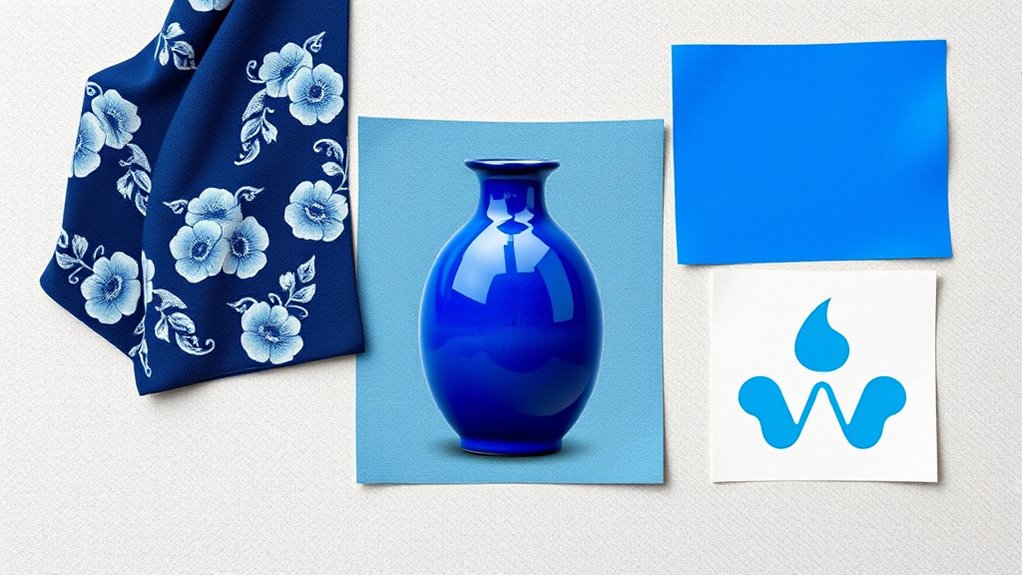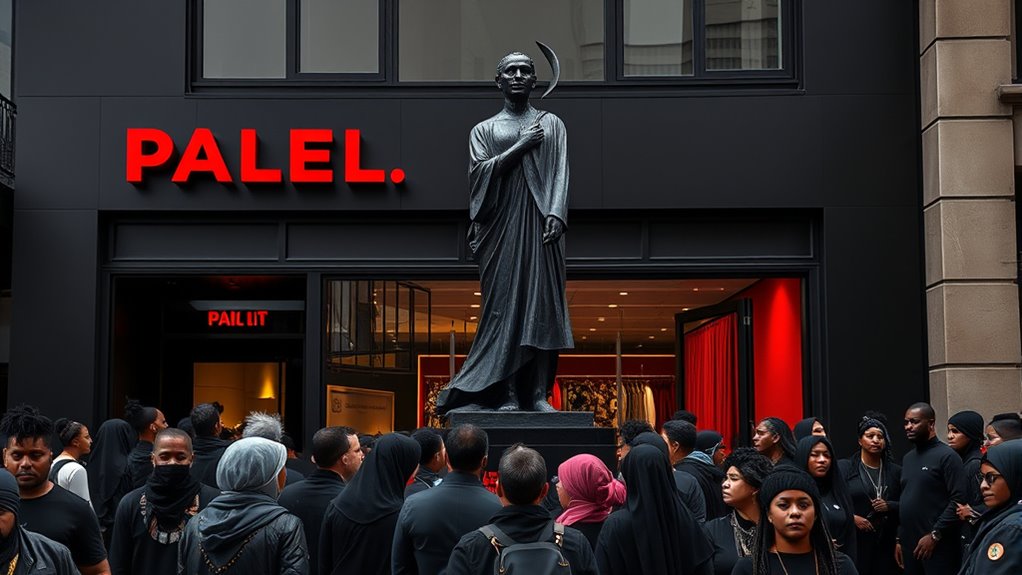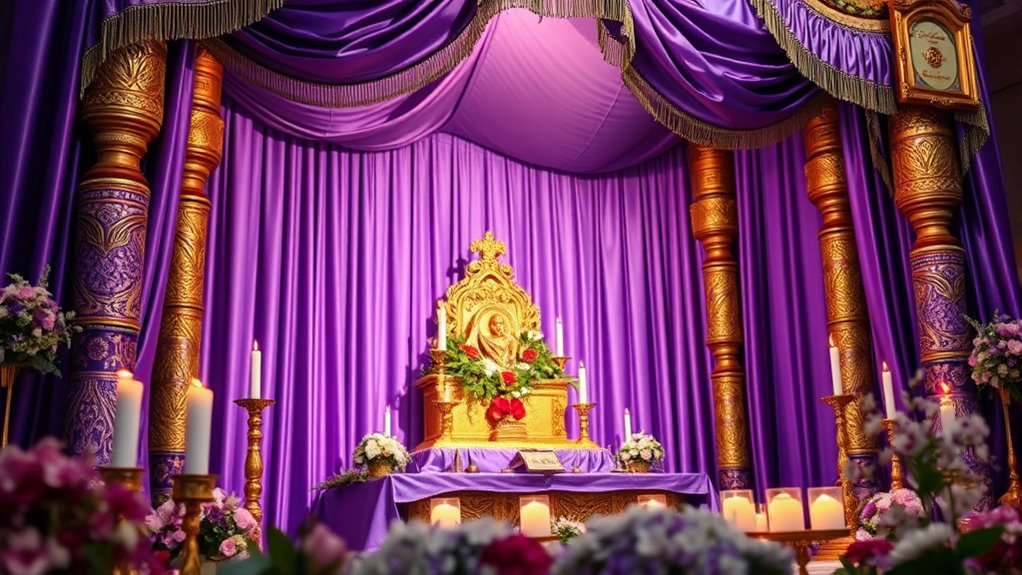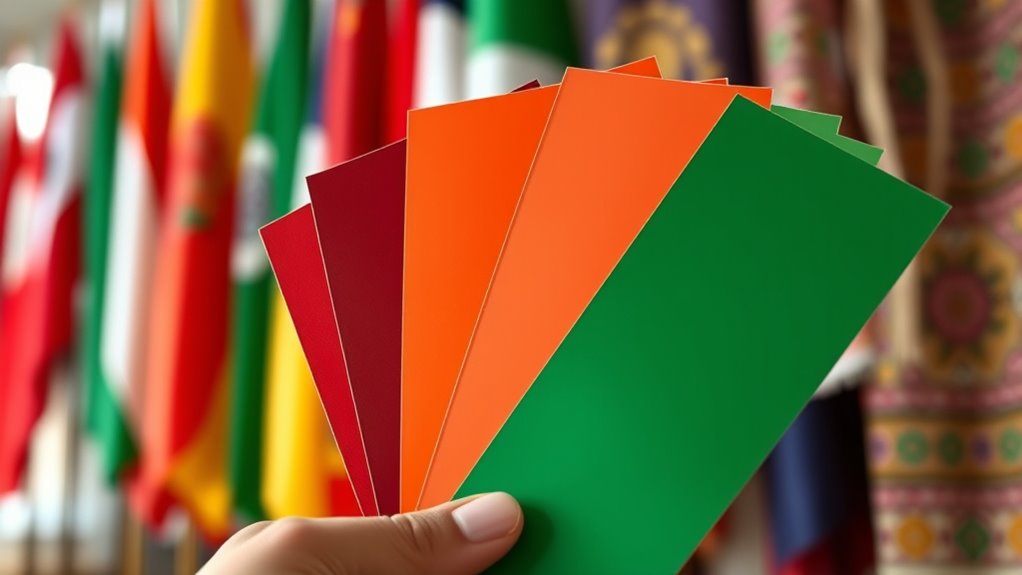Understanding the cultural symbolism of colors is key to creating effective branding that connects globally. Colors like red symbolize luck and celebration in China, while white can mean purity or mourning, depending on the culture. Blue often stands for trust, Green signals growth, and yellow varies from happiness to caution worldwide. Recognizing these nuances helps you avoid miscommunication and build authentic connections. Explore further to discover how to adapt your branding for diverse cultural contexts.
Key Takeaways
- Colors evoke different emotions and meanings across cultures, influencing brand perception globally.
- Understanding regional color symbolism helps brands avoid miscommunication and cultural insensitivity.
- Cultural associations of colors, such as red for luck or white for mourning, impact marketing strategies.
- Symbolic color meanings can vary significantly within regions, requiring localized branding approaches.
- Incorporating culturally appropriate colors enhances authenticity, emotional connection, and brand acceptance worldwide.
The Significance of Red in Different Cultures

Red holds powerful symbolic meaning across many cultures, often representing passion, energy, or danger. In China, red signifies good luck, prosperity, and celebration, making it a popular choice for weddings and festivals. Conversely, in Western cultures, red can evoke excitement but also warning, as seen in stop signs or danger signals. In India, red symbolizes purity and fertility, frequently worn in bridal attire. Meanwhile, in some African traditions, red represents life and vibrancy but can also be associated with aggression or conflict. Its versatility allows it to convey strong emotions and messages worldwide. When used in branding, understanding these cultural nuances helps you connect with audiences authentically and avoid misinterpretations that could harm your brand’s reputation. Additionally, cultural symbolism plays a crucial role in shaping consumer perceptions and brand loyalty. Being aware of color perception differences across cultures can enhance marketing strategies and promote positive brand associations globally, especially considering how hackathon communities often span diverse backgrounds and cultural contexts. Recognizing the role of attention in creative practice can also influence how brands craft visual identities to capture audience focus effectively.
White: Purity, Mourning, and Beyond

White often symbolizes purity, innocence, and new beginnings, making it a popular choice in various cultural and branding contexts. It conveys cleanliness, simplicity, and elegance, yet also carries different meanings depending on the culture. In some traditions, white is associated with mourning and funerals, symbolizing respect and remembrance. Conversely, in Western cultures, it’s often linked to weddings and celebrations of fresh starts. Understanding these nuances helps you choose the right tone for your brand. Here’s a quick overview:
| Aspect | Cultural Context | Typical Usage |
|---|---|---|
| Purity | Western, religious | Weddings, health products |
| Mourning | East Asian, Western | Funerals, memorials |
| Innocence | Childhood, youth | Baby products, innocence campaigns |
| New Beginnings | Western, spiritual | Graduation, new ventures |
Additionally, the psychological impact of white can influence consumer perceptions, making it a powerful tool in branding strategies. Recognizing the cultural symbolism associated with white helps ensure your branding resonates appropriately across diverse markets. For example, incorporating color symbolism thoughtfully can evoke specific emotional responses aligned with your brand identity.
The Cultural Meaning of Blue Across Continents

Blue often symbolizes trust and reliability in many cultures, shaping how brands use it worldwide. In some regions, it holds spiritual significance, representing calmness or divine connection. You’ll also find that economic associations with blue influence corporate branding in various continents, reflecting stability and professionalism. Additionally, the cultural symbolism of color plays a key role in shaping consumer perceptions and brand identity across different societies. The psychological impact of color can further enhance brand messaging and influence purchasing decisions. Recognizing the use of cookies in digital branding strategies helps companies better connect with their audiences and respect privacy preferences. Understanding these cultural meanings can help businesses tailor their branding strategies to resonate more effectively with diverse audiences. Moreover, the sound design principles used in advertising can subtly reinforce these color associations through auditory cues.
Trust and Reliability
Across many cultures, the color blue is universally associated with trust and reliability, making it a popular choice for brands aiming to convey stability. Blue’s calming effect fosters confidence and reassurance in consumers. In Western countries, blue symbolizes professionalism and dependability, often used by banks and tech companies. In Asian cultures, blue signifies harmony and peace, reinforcing a brand’s trustworthy image. Meanwhile, in some Middle Eastern regions, blue wards off evil and promotes safety. Here’s a quick overview:
| Culture | Meaning of Blue |
|---|---|
| Western | Trust, professionalism |
| Asian | Harmony, peace |
| Middle Eastern | Safety, protection |
| Latin America | Loyalty, stability |
| Africa | Wisdom, spiritual significance |
Using blue strategically can strengthen your brand’s message of trust across diverse markets. Additionally, understanding the cultural symbolism of color can help tailor branding strategies to resonate effectively with different audiences. Recognizing the cultural connotations of color can also aid in avoiding misinterpretations that might undermine brand credibility. Moreover, awareness of regional differences in color perception allows brands to customize their messaging to better connect with local consumers. For instance, the black coat in the Golden Retriever breed demonstrates how color variations can carry specific meanings and implications in branding and identity.
Spiritual Significance
Throughout many cultures, blue is more than just a calming hue; it holds deep spiritual significance that varies from region to region. In some societies, blue symbolizes the divine, representing heaven or the spiritual sphere. In others, it’s associated with protection against evil spirits or bad luck. You’ll find blue used in religious ceremonies and sacred objects, emphasizing its connection to higher powers. Its soothing quality also fosters a sense of peace and trust during spiritual practices.
- In Ancient Egypt, blue represented protection and was linked to the gods.
- In Hinduism, blue symbolizes divine qualities like wisdom and calmness.
- In Christianity, it’s often associated with the Virgin Mary and purity.
- In many Indigenous cultures, blue signifies connection to the spiritual world.
Economic Associations
The spiritual significance of blue often influences its economic value in various regions. In Western countries, blue’s association with trust and professionalism makes it popular for corporate branding, boosting sales and brand recognition. In the Middle East, blue is linked to protection and spirituality, increasing demand for blue-colored jewelry and textiles. In Asia, especially China and Japan, blue signifies stability and harmony, leading to a thriving market for blue ceramics and fashion. Conversely, in some African cultures, blue symbolizes healing and fertility, which enhances its value in traditional crafts. Overall, these cultural meanings shape consumer preferences and influence the economic demand for blue products worldwide, demonstrating how deep-seated cultural associations can directly impact market dynamics and branding strategies.
Green: Growth, Luck, and Cultural Variations

Green often symbolizes growth and luck, but its meanings can vary widely across cultures. In some regions, green is associated with prosperity and renewal, making it ideal for brands promoting eco-friendly products or health. However, in others, it can represent jealousy or inexperience. Understanding these nuances helps you choose the right shade and context for your branding.
- In Western cultures, green typically signifies health and environmental awareness.
- In Ireland, it’s linked to luck and national identity.
- In some Middle Eastern countries, green is a sacred color with religious significance.
- In parts of Asia, green can symbolize youth or new beginnings but also envy.
Yellow’s Diverse Symbolism in Global Contexts

Yellow often symbolizes brightness and optimism, making it a popular choice to evoke positive feelings. However, its meaning varies across cultures; in some regions, it signifies happiness, while in others, it can represent caution or even warning. Understanding these differences helps you use yellow effectively in global branding strategies.
Brightness and Optimism
Bright hues like yellow often evoke feelings of happiness and hope across many cultures, making them powerful tools in branding. They instantly grab attention and can convey a sense of optimism and positivity. When used effectively, yellow can uplift a brand’s image, encouraging trust and friendliness. Its energetic vibe attracts consumers looking for cheerfulness and clarity. However, you should consider cultural contexts, as perceptions of yellow can vary. For example, in some regions, it symbolizes caution or cowardice. To harness yellow’s brightness and optimism, focus on:
- Creating a welcoming and energetic brand identity
- Using yellow to highlight innovative or cheerful products
- Combining it with other colors for balanced messaging
- Being mindful of cultural nuances to avoid misinterpretation
Cultural Variations in Meaning
While yellow is often associated with happiness and positivity in many Western cultures, its meaning can vary markedly across different societies. In China, yellow symbolizes royalty, prosperity, and power, often linked to the emperor’s attire. Conversely, in some parts of the Middle East, yellow may signify caution or betrayal. In Japan, yellow can represent courage and wealth, but also carries connotations of cowardice, depending on context. In India, yellow is a sacred color associated with spirituality and learning, often used in religious ceremonies. These variations mean that using yellow in branding requires cultural awareness. What resonates positively in one society could be misunderstood or carry negative associations elsewhere. Understanding these differences helps you craft messages that are culturally appropriate and effective across diverse markets.
Black: Power, Mourning, and Modern Interpretations

Black has long been associated with power and authority, making it a popular choice for brands that want to convey strength and sophistication. It symbolizes elegance, control, and professionalism. However, black also has somber connotations related to mourning and loss, especially in Western cultures. Today, many brands use black to evoke modernity, luxury, and timeless style. It’s versatile, adaptable across industries, and communicates confidence. But be mindful of its cultural implications, as it can also suggest rebellion or seriousness. When used thoughtfully, black can enhance your brand’s image by blending tradition with contemporary appeal.
- Represents authority, elegance, and sophistication
- Linked to mourning and solemnity
- Conveys modernity and luxury
- Evokes confidence and power
The Role of Purple in Cultural and Religious Traditions

Purple has long symbolized royalty and power in many cultures, making it a color of prestige. You’ll also see its spiritual significance in religious traditions worldwide, representing reverence and enlightenment. Keep in mind, its meanings can vary greatly, reflecting different cultural and historical contexts.
Royalty and Power
Throughout history, the color purple has been a powerful symbol of royalty and authority. It’s often associated with monarchs, aristocrats, and leaders, signifying status and power. This connection originated because purple dyes were rare and expensive, making it accessible only to the elite. When you see purple in branding, it evokes sophistication, prestige, and influence. Its use in religious and political contexts further reinforces its association with dominance and divine right. Purple’s rich tone commands attention and respect, making it a strategic choice for brands aiming to communicate luxury or authority.
- Historically reserved for kings and queens due to cost
- Used in religious garments to denote sanctity and power
- Symbolizes sovereignty in many cultures
- Reinforces a sense of exclusivity and prestige
Spiritual Significance
In many cultural and religious traditions, purple carries deep spiritual significance, symbolizing connection to the divine, enlightenment, and higher consciousness. You’ll find it used in sacred rituals, religious garments, and spiritual iconography to represent transcendence and spiritual authority. Purple’s rarity in nature historically elevated its status, making it a color associated with sacredness and reverence. In Christianity, purple signifies penance and preparation, often seen during Lent and Advent. In Hinduism and Buddhism, it’s linked to spiritual awakening and wisdom. As you see, purple’s rich hue embodies a bridge between the earthly and the divine, inspiring reverence and introspection. Its presence in spiritual contexts underscores its power to evoke a sense of sacredness and a deeper connection beyond the material world.
Cultural Variations
Across different cultures and religious traditions, the significance of purple varies widely, reflecting unique beliefs and values. In some societies, purple symbolizes royalty, spirituality, or spiritual authority, while in others, it may represent mourning or penance. For example, in Western Christianity, purple is associated with Lent and penitence, whereas in Thailand, it’s linked to mourning for specific occasions. Your understanding of purple’s cultural meaning can influence your branding strategies to resonate more deeply with local audiences. Keep in mind:
- Purple as a royal or noble color in Western cultures
- Its association with spirituality in religious contexts
- Use during mourning in certain Asian traditions
- Its role in representing luxury and wealth globally
Recognizing these variations helps you adapt your branding to diverse cultural perceptions.
Orange: Energy, Caution, and Cultural Significance

Orange is a vibrant color that often symbolizes energy and enthusiasm, making it a popular choice in branding to grab attention and evoke excitement. It’s associated with warmth, vigor, and a sense of adventure. However, orange can also signal caution, similar to traffic cones and warning signs, prompting awareness and alertness. Its cultural significance varies globally: in some cultures, orange represents spirituality or prosperity, while in others, it symbolizes warning or danger. This duality influences how you choose orange in branding strategies. Consider the context and target audience carefully.
| Positive Associations | Cautionary Signals |
|---|---|
| Energy and vitality | Warning signs |
| Creativity | Alertness |
| Warmth and friendliness | Danger symbols |
Cultural Sensitivities in Choosing Brand Colors

When selecting brand colors, understanding cultural sensitivities is crucial because colors can carry vastly different meanings across societies. A color that symbolizes good luck in one culture may represent mourning in another, risking miscommunication or offense. You need to research target markets thoroughly to avoid unintended negative associations.
Be mindful of:
- Historical connotations that may influence perceptions of certain colors
- Religious significance tied to specific hues within cultures
- Political implications that could be linked to particular colors
- Regional differences where color meanings may vary even within the same country
Ignoring these sensitivities can harm your brand’s reputation and alienate potential customers. Always consider cultural context to ensure your brand colors resonate positively worldwide.
Strategies for Cross-Cultural Color Adaptation

To effectively adapt your brand’s colors for different cultures, you must develop flexible strategies that account for diverse meanings and sensitivities. Start by researching each target market’s cultural associations with colors, identifying positive and negative connotations. Consider creating adaptable color palettes that can be modified based on regional preferences, avoiding a one-size-fits-all approach. Test your color choices with local focus groups or through A/B testing to gauge reactions. Collaborate with local designers or cultural experts to ensure your color adaptations resonate authentically. Keep in mind that meanings can evolve, so stay updated on cultural shifts. By remaining versatile and attentive, you’ll build a brand that respects cultural nuances while maintaining visual consistency across markets.
Frequently Asked Questions
How Do Color Symbols Influence Consumer Behavior Across Different Cultures?
Understanding how color symbols influence consumer behavior across cultures helps you tailor branding strategies effectively. You realize that colors evoke different emotions and associations depending on cultural backgrounds. For example, red signifies luck in China but warns of danger in the West. By recognizing these differences, you can choose colors that resonate positively with your target audience, increasing engagement and brand loyalty worldwide.
Are There Universal Color Meanings Recognized Worldwide in Branding?
You might wonder if certain colors hold the same meaning worldwide in branding. While some colors like red for excitement or passion are widely recognized, many color meanings vary across cultures. You should understand that universal perceptions are limited, and local cultural symbolism often influences consumer reactions more than global color associations. To succeed globally, you need to adapt your branding colors to fit each culture’s unique symbolism.
How Can Brands Avoid Cultural Misinterpretations in Color Choices?
Did you know that 85% of consumers say color is the primary reason they buy a product? To avoid cultural misinterpretations, you should research your target markets thoroughly, understanding local color meanings and customs. Collaborate with local experts or cultural consultants, and test your branding visuals with diverse focus groups. This proactive approach guarantees your brand’s colors resonate positively worldwide, preventing costly misunderstandings.
What Role Does History Play in Shaping Color Symbolism in Branding?
History plays a vital role in shaping color symbolism in branding because it influences how colors are perceived over time. You should consider historical associations and events that have given colors specific meanings in different cultures. By understanding this history, you can make more informed branding decisions, ensuring your color choices resonate positively and avoid unintended negative connotations. This awareness helps you create a brand image that’s culturally sensitive and meaningful.
How Do Emerging Digital Trends Impact Traditional Color Symbolism?
You see, emerging digital trends like social media and virtual reality reshape how you perceive and use colors. These trends often challenge traditional symbolism, making bold, vibrant hues more popular to grab attention online. You’re encouraged to experiment with color palettes, blending old meanings with new digital aesthetics. This shift impacts branding by fostering more dynamic, engaging visuals that resonate with digital audiences, ultimately redefining color’s role in brand identity.
Conclusion
Understanding the cultural symbolism of color helps you connect more deeply, communicate more clearly, and respect diverse perspectives. It’s about recognizing the meanings behind hues, appreciating their significance, and adapting your brand accordingly. By embracing cultural nuances, you guarantee your message resonates, your brand respects traditions, and your audience feels understood. Ultimately, mastering color symbolism empowers you to create authentic, meaningful, and culturally sensitive branding that stands out and builds trust worldwide.









